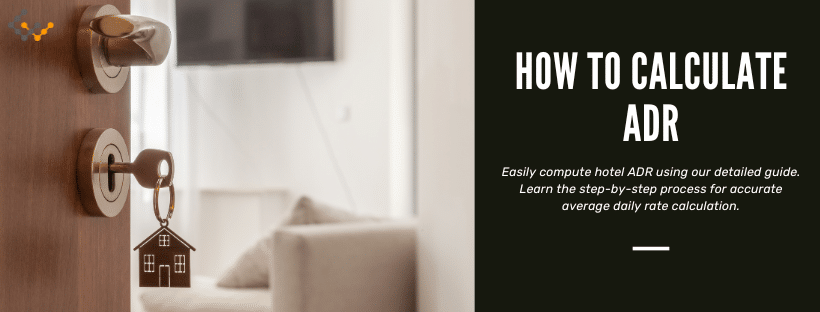Average Daily Rate Calculator: ADR Formula and Calculations

Businesses in the hospitality industry derive the bulk of their revenue from room sales. One of the key metrics used to understand room revenues is the average daily rate (ADR). If you’re investing in a hotel, motel, bed and breakfast or other lodging, it’s vitally important that you understand how to calculate ADR.
What is the Average Daily Rate or ADR?
The average daily rate (ADR) is a standard metric used by hotels, motels, bed and breakfasts, and others in the hospitality industry. It’s used to calculate the average revenue received for each occupied room, on a daily basis.
In other words, ADR is a snapshot of how much guests are paying on average for a one-night stay. Knowing this helps inform pricing strategies, positioning within the local market, and assessing the overall financial health of a business.
Answer a few questions and get custom mortgage quotes. We'll match you with offers from our network of 650+ lenders.
Why is the Average Daily Rate (ADR) Important?
All stakeholders involved with a hospitality business must understand ADR. Managers and marketers need to know ADR so that they can develop effective pricing strategies. Investors need to know it so that they can evaluate properties’ performances.
Knowing a property’s ADR is helpful in multiple ways:
- Revenue Indication: The core purpose of ADR is to highlight revenue generated solely from room sales, excluding revenue streams such as food, beverages, spa services, event space, etc. It’s a quick measure to gauge the earning capacity of the primary service — the rooms.
- Performance Measure: Tracking ADR over time allows managers and investors to assess performance trends. Performance can be evaluated on a weekly, monthly, or yearly basis, by comparing current ADR with past ADR data. It can additionally be helpful when comparing performance to competitors.
- Pricing Strategy: The average amount paid for a room should generally be fairly consistent, with allowances for weekends, peak season, special events, etc.
- A fluctuating ADR can indicate an issue with pricing strategy. Constant changes in ADR suggest that pricing changes, special discounts, and promotional campaigns are being used regularly, which may not be the best marketing tactic.
How to Calculate Average Daily Rate
Calculating the average daily rate of a property is straightforward. To calculate ADR, divide total room revenue by the number of rooms sold.
ADR = Total Room Revenue / Number of Rooms Sold
The figures used should be for whatever time frame is being analyzed, whether that’s a week, month, quarter, year, or some other period.
Examples of How ADR is Calculated
A few examples show how ADR might be calculated for various types of lodging. All hospitality businesses use the same formula, but they could have quite different ADRs:
- A standard hotel in a major city might want to know its ADR over the course of a month. If the hotel had a room revenue of $300,000 and sold 3,000 rooms, its ADR would be $100 for the month. ($300,000 / $3,000 rooms = $100/room).
- A boutique hotel might want to know its ADR for a 3-day special event in the area. If the hotel had room revenue of $9,000 and sold 30 rooms, its ADR would be $300 for the event ($9,000 / 30 rooms = $300/room).
- A small bed and breakfast might want to know its yearly ADR. If the B&B had $360,000 in annual room revenue and sold 1,800 rooms, its ADR would be $200 ($360,000 / 1,800 rooms = $200/room).
- An older motel might want to know its ADR for the area’s 3-month peak season. If the motel had room revenue of $240,000 and sold 3,000 rooms, its ADR would be $80 ($240,000 / 3,000 rooms = $80).
ADR vs RevPAR: Similarities and Differences
Average daily rate is similar to revenue per available room (RevPAR), but the two show different metrics. They shouldn’t be conflated with each other:
- ADR: Shows the average revenue generated by each sold room. This doesn’t take into account the occupancy rate.
- RevPAR: Shows the revenue per each available room, regardless of whether the room is sold or unsold. This is a more comprehensive picture that incorporates the occupancy rate.
RevPAR can be calculated based on or apart from ADR. A couple of formulas for RevPAR are:
RevPAR = ADR x Occupancy Rate
RevPAR = Total Room Revenue / Total Available Rooms
ADR is helpful when evaluating pricing, while RevPAR is more informative when evaluating performance compared to capacity.
How to Improve Average Daily Rate
Boosting a property’s average daily rate has obvious benefits. An increase in the per-day revenue from a business’s primary revenue stream can substantially boost the bottom line.
Obviously, an increase in demand for rooms in the area will likely have a direct positive effect on ADR. Higher ADRs should be expected during peak season, major events, and the like. Managers and investors usually have little control over these, however.
Other steps can be taken to actively increase ADR for a property. Some strategies that are usually effective include:
- Dynamic Pricing: Implement a pricing model that responds to demand and supply. Increasing rates during busy times will increase the price paid per room. Rates can be kept stable during slower times for a decent ADR, or they can be lowered for a reduced ADR but higher RevPAR (because of the increased occupancy rate). Dynamic pricing is particularly effective if in a tourist area, college town, or other region that sees large influxes of visitors at specific times.
- Complementary Services: Offering complimentary services, such as free breakfast or an airport shuttle, can be value-adds that customers will pay more for. The increased payment is shown in room revenue since separate fees aren’t charged for these services.
- Additional Amenities: Regardless of whether they’re free, other amenities can greatly improve how much guests are willing to pay for a room. Many guests will pay higher rates if there’s a pool, exercise room, on-site bar, laundry facilities or similar features.
- Update Rooms: Updated rooms not only attract more guests but also command higher prices because of the nicer decor and furnishings. A refresh might be expensive, but it could pay for itself in the form of higher ADR.
- Competition: Rather than competing by undercutting competitors in the area, instead focus on providing a nicer experience. Use the other ideas to stand out and get more bookings, without having to sacrifice on price so much.
- Book Directly: Encourage customers to book directly, possibly by offering an incentive to do so. This will provide more revenue for each room sold than when customers book through third-party sites.
Wrapping Up
If you’re involved with a hospitality property, or soon might be, make sure you understand average daily rate. Knowing the ADR of your property will provide important insight into pricing effectiveness, and be useful when evaluating performance.

